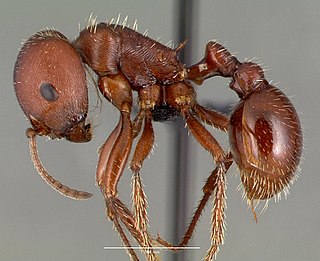
Messor is a myrmicine genus of ants with more than 100 species, all of which are harvester ants; the generic name comes from the Roman god of crops and harvest, Messor. The subterranean colonies tend to be found in open fields and near roadsides, openings are directly to the surface.

Myrmicinae is a subfamily of ants, with about 140 extant genera; their distribution is cosmopolitan. The pupae lack cocoons. Some species retain a functional sting. The petioles of Myrmicinae consist of two nodes. The nests are permanent and in soil, rotting wood, under stones, or in trees.

Pogonomyrmex is a genus of harvester ants, occurring primarily in the deserts of North, Central, and South America, with a single endemic species from Haiti.

Cephalotes is a genus of tree-dwelling ant species from the Americas, commonly known as turtle ants. All appear to be gliding ants, with the ability to "parachute" and steer their fall so as to land back on the tree trunk rather than fall to the ground, which is often flooded.

Aphaenogaster is a genus of myrmicine ants. About 200 species have been described, including 18 fossil species. They occur worldwide except in South America south of Colombia, sub-Saharan Africa, and Antarctica.

Tetramorium is a genus of ants in the subfamily Myrmicinae that includes more than 520 species. These ants are also known as pavement ants.

Crematogastrini is a tribe of myrmicine ants with 64 genera and 8 fossil genera.

Anochetus is a genus of small, carnivorous ants found in the tropics and subtropics throughout the world.

Hypoponera is a genus of ants in the subfamily Ponerinae. The genus has a worldwide distribution and is found in all continents except Antarctica.

Platythyrea is a genus of predaceous ants in the subfamily Ponerinae and the sole member of the tribe Platythyreini.

Dolichoderus is a genus of ants found worldwide.

Technomyrmex is a genus of ants in the subfamily Dolichoderinae. With 98 species, it is one of the largest and most diverse ant genera in the Dolichoderinae. The genus distributed throughout the tropical and subtropical zones with most species occurring in the Oriental-Malesian and Afrotropical regions. One species, Technomyrmex albipes is a tramp ant now widespread throughout the tropics due to human activities.

Gnamptogenys is a genus of ants in the subfamily Ectatomminae. The genus has a wide distribution. It is known to occur in the Nearctic, Neotropic, Indomalayan and Australasian realms.

Cataulacus is a genus of ants in the subfamily Myrmicinae. The genus is distributed in the Paleotropical regions, mainly in the Afrotropics. Most species are found in forests, but a few are known from more open and arid habitats.

Carebara is a genus of ants in the subfamily Myrmicinae. It is one of the largest myrmicine genera with more than 200 species distributed worldwide in the tropics and the Afrotropical region. Many of them are very tiny cryptic soil and leaf-litter inhabitants. They nest in rotten wood to which the bark is still adherent in the Afrotropical region, or may be lestobiotic nesting near other ant species. Some species are known to exist parasitically within termite nests. Little is known about the biology of the genus, but they are notable for the vast difference in size between queens and workers.

Zasphinctus is a genus of ants in the subfamily Dorylinae. The genus is a pantropical and distinctive group, originally described by Wheeler (1918) based on "Sphinctomyrmex" turneri collected in Queensland, Australia. Zasphinctus was first described as a subgenus of "Eusphinctus", and then synonymized into Sphinctomyrmex, to later be raised to full genus status by Borowiec (2016), who included approximately 20 species in the new genus circumscription.

Ponerini is a tribe of Ponerinae ants with 46 genera and 6 extinct genera.

















